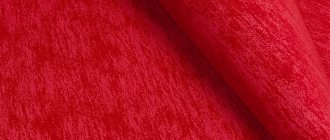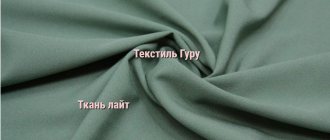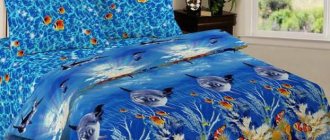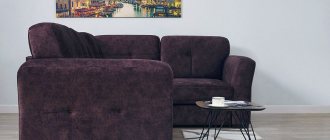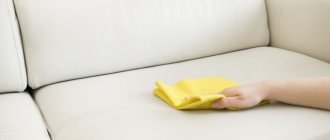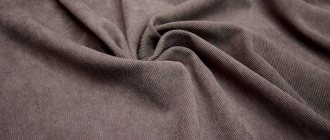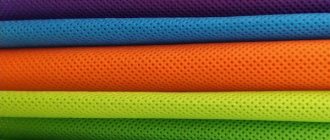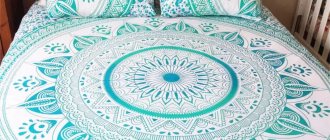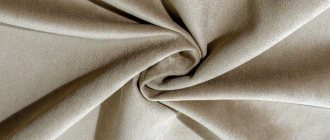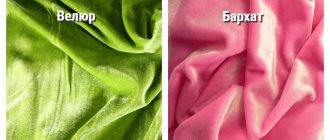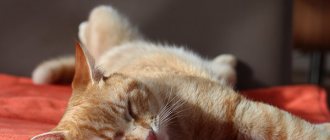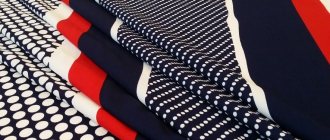A lot of different materials, both natural and artificial, are used to produce shoes. Particularly interesting is velor - a luxurious velvety fabric that will add sophistication to any outfit. Not everyone knows what natural velor is, what kind of shoe material it is, and how convenient it is to use. Fuzzy leather is very soft, so it not only looks great, but also does not cause any inconvenience when caring for shoes. Beauty, safety, comfort - qualities that incline the choice to velor.
What kind of material is velor
Velor is the name of not just one type of fabric, but a whole group of materials. The feature that unites them is the presence of pile, the length of which is slightly longer than that of velvet.
The material has a matte surface. Due to the special texture of velor, glare is formed when worn. Because of this, even uniformly colored fabric shimmers in different shades, creating an unusual effect.
Velor is a dense and durable material. But it does not tear or come apart along the seam under physical impact. If the material is purposefully pulled in different directions, it becomes deformed.
To the touch, the velor on the front side is fluffy and soft, and on the back side it is smooth with a slight relief. Thanks to the special weaving, even synthetic material is breathable. The fabric does not wrinkle.
The fabric is quite elastic and stretches well. Fits beautifully to the figure, hugging its contours. Due to the ability to form glare and a fairly large thickness, it can fill up. Characteristics may vary depending on the type of velor.
For the first time, velor began to be produced in the East as a replacement for expensive velvet. At the same time, velor fabric was expensive and was available only to the aristocracy. The material received its modern name in France. Velor is translated from French as “velvet”.
Corduroy looks and feels similar to velor. However, the first option has protruding stripes on the front side.
Typically, one of two technologies is used to make velor:
- Single panel technique. A rod is inserted under the threads from which the pile will be formed. The fabric is woven together with it. The rod is removed from the fixed loops. Next there are two options. In the first case, the loops are not cut, resulting in looped velor. In the second case, the loops are cut, then split velor is obtained.
- Double-panel. When weaving, two main threads are used at once. Two fabrics are woven from weft threads, connected to each other by a zigzag pile thread. The pile layer is evenly cut with special knives on machines. To weave the material using the two-sheet technique, 5 threads are used.
In addition to velor fabrics, you can find velor thread (sisal, bobbin velor) in sewing stores. During its manufacture, fibers are attached to the central single-twist thread.
Velor knitwear has a different weaving technology. The plush technique is used, which involves weaving loops with broaching.
Initially, fabric was made only from natural materials: wool, silk, cotton, leather. Nowadays synthetic and semi-synthetic materials are more common. Polyester and viscose are used for weaving fabrics. To increase elasticity and wear resistance, elastane and lycra are added.
The cost of velor depends on the composition. This figure varies between 150–3000 rubles per 1 sq. m. m.
How to clean velor shoes at home
You can clean velor shoes at home. It is allowed to use both store-bought and improvised products. The main thing is to stock up on the necessary tools and substances.
How can you clean velor shoes and what not?
The best cleaning products will be special aerosols and cleaners, which, in addition to their main function, tint the surface of the velor. It is not forbidden to use improvised means: laundry soap, peroxide, diluted ammonia or vinegar. Washing or treating velor products with aggressive and abrasive substances is strictly prohibited.
Which tool should I use?
In your arsenal of tools for cleaning velor, as well as maintaining its decent appearance, you should have:
- soft brushes for daily dust removal;
- stiffer brushes to remove traces of dirt;
- rubber brushes and eraser for cleaning difficult stains;
- flannel napkins for using improvised means.
You can buy all the tools at a shoe or specialty store immediately after purchasing the shoes.
Methods for removing stains and dirt from velor shoes
First of all, after choosing a cleaning method, test the substance on a small area. If the material is not deformed and remains as it was, feel free to use the chosen method.
The treatment method depends on the degree of contamination:
- Treat strong stubborn traces of dirt with a sponge soaked in purified gasoline. After this, apply talc or potato starch to the surface and leave for an hour. This will help remove any remaining substance. Then brush off the talc and lift the velor pile with a special brush.
- A solution of potassium permanganate, peroxide, tooth powder or soda will help remove the unpleasant odor. Treat with liquids very carefully, touching only the inner surface with a damp cloth. First pour the dry substances inside, and after 30 minutes remove them with a vacuum cleaner.
- Try to remove less persistent stains with ethyl alcohol. It removes dust and fresh traces of dirt well.
- You can remove fresh marks with a crust of white bread. To do this, gently rub the crust into the surface in a circular motion, and then brush off any remaining crumbs with a brush.
- If drops of moisture get on the surface of the boots and the pile becomes crumpled, steam treatment will help. Simply hold the product over boiling water for 1-2 minutes to “steam” the surface. Then dry the material with a flannel cloth, and after half an hour, comb the pile with a suitable brush.
Types of velor
The concept of “velor” unites a whole group of fabrics with a fleecy surface. First of all, materials are classified by composition:
- Cotton. Natural fabric woven from long or short cotton fibers. To achieve a stretch effect, elastane, spandex, and lycra threads are added to the fabric. Knitted velor is woven from cotton. Natural material is characterized by high density, softness, hygiene and high aeration.
- Woolen. Uncombed fluffy wool fibers are used to make it. Sometimes artificial threads are added to the composition. The fabric is thick and warm. The material is used to make blankets, outerwear, and hats.
- Drapey. Merino wool is used to produce drape velor. Weaving is done using satin technique. The fabric is thin, light, durable and warm. This is a luxury option.
- Leather (natural) and split leather. Made from leather, the outer side of which has defects. In this case, the front side becomes a fleecy surface. Used for sewing footwear and bags. Natural velor is often confused with suede material, but the second option is less delicate and has a shorter pile.
- Artificial (synthetic). Made from polyester or viscose with the addition of lycra and elastane.
- Fur. Obtained using special grinding, which increases the thermal insulation properties of the material. In essence, it is leather velor, which has retained the fur layer on one side.
- Micro velor fabric. Thin synthetic material with short pile. It is characterized by increased wear resistance and hygroscopicity. It is used as lining fabric, as well as for sewing insoles. Microvelor "Enigma" has many color options.
The fabric is divided into types according to the method of weaving the fabrics. The following options are available:
- Knitted velor. For production, knitting technique with broaching is used. It is characterized by high elasticity, the ability to stretch in different directions, and wear resistance.
- Material with twill or satin weave. When using this technology, expensive royal fabric is obtained. The front side of the material acquires a light satin glow.
- Moire. The main feature of the fabric is that on the front side, piles of different lengths form patterns that become noticeable when the lighting changes.
- Jacquard velor. Jacquard weaving is used, which uses both the same type of threads and lurex with silk. Such canvases are distinguished by the presence of large and small patterns formed from areas with different textures. Used for furniture and cars.
To view the fabric review:
Velor is classified according to its purpose. The following types of material are distinguished:
- For sewing clothes. For these purposes, natural, wool, cotton, synthetic, and drape velor are used. These are thin, but dense and durable materials.
- Furniture. Consists of a durable base and soft bristles. Anti-vandal velor anti-claw is especially popular. It does not fray, does not wear out and does not lose its aesthetic appearance over time, and is not afraid of moisture. It does not show scratches from animal claws. Furniture materials also include flock and matting. Seamless self-adhesive velor is available for sale and can be used to decorate furniture yourself. Among the furniture materials, the most famous are Astra, Virginia and Silkshine fabrics.
- Automotive. This is a durable, wear-resistant material for interior trim. It is often used in Japanese-made cars. Caprovelur is also used for cars, which, thanks to the foam and mesh base, is characterized by increased wear resistance.
- Curtain. Used for sewing curtains.
The last parameter by which the material is divided into varieties is its appearance and processing method:
- Smooth. It has a pile of the same length over the entire area of the canvas.
- Smoothly colored. The finished fabric or threads are painted in one color. The most popular: black, blue, pink, green, red, brown, gray, beige. Plain-dyed fabric looks interesting because it shimmers in different shades depending on the lighting.
- Shaped. The pile is smoothed in places, which gives the material a heterogeneous appearance.
- Embossed. It has patterns formed from smoothed pile.
- Printed. The color design is printed over the entire surface.
See what furniture fabric looks like:
Origin story
The material first appeared in the Ancient East, where it was a silk fabric with pile, which was decorated with gold and silver embroidery, as well as expensive braid. Velor was a cheap variation of velvet: they are often compared, confused and classified into the same group of fabrics.
From the East, the material first came to Europe, where it stood alongside velvet. Expensive velor was popular in secular circles, emphasizing the status of its wearers. Only then, following European fashion, did representatives of the nobility in Russia begin to dress in it.
Velvet
Luxurious velvet fabric: a detailed review
more details
Advantages and disadvantages of the material
Velor is popular due to a number of advantages. They are presented in the list:
- Strength, durability. The fabric is resistant to physical impact, wear, and stretching. Some species are not afraid even of animal claws. They do not wear out, do not stretch, do not shrink, and do not lose their attractive appearance over time.
- Pleasant tactile sensations. The softness of the fabric makes it comfortable to wear and use.
- Low thermal conductivity. The material protects from the cold.
- Color fastness. The fibers hold the dye well. The material does not fade or fade. The color remains vibrant even after several washes. There is a special paint for velor.
- Beauty. The fabric looks expensive and noble; highlights and halftones are formed on it. The material hugs the body beautifully.
- Easy to care for. The fabric does not wrinkle and does not need to be ironed. Contaminants are easily washed off from things.
Matter has disadvantages that need to be taken into account when purchasing products:
- If not properly cared for, the material quickly loses its attractive appearance. During its operation, it is important to follow the basic rules.
- Quickly absorbs water along with dirt. Gets dirty easily.
- When washed, it loses some of the lint. Areas appear in which the pile is directed in different directions. The matter begins to look sloppy.
Watch the video:
Which to choose?
The choice of a velor sofa should be approached with great responsibility. The color of the product plays a very important role when choosing.
Designers recommend choosing the shade of the sofa that will harmoniously combine with other interior items and become its important component. In this case, it is necessary to take into account your lifestyle, as well as your character.
After all, some people like bright colors, while others are delighted with calmer shades.
Each interior style includes a combination of certain color schemes, which should definitely be taken into account when choosing a velor sofa. They all have individual characteristics:
- Red . For some it can cause aggression, but for others it can become a symbol of romance and comfort. The most original way such a sofa complements interior design in the style of Art Deco, High-Tech, Constructivism and Techno.
- Blue. Psychologists say that this color has a positive effect on the human psyche, conducive to relaxation and tranquility. They can often be found in a classic style.
- Green. A velor sofa in this color can become the center of everyone's attention. It goes well with yellow, blue, pink and red items. This shade can cause drowsiness. It complements the Baroque style well.
- Brown. The presence of such a sofa ensures the creation of comfort and coziness. It is used in Country, Empire, Renaissance, Classic and Rococo styles. It goes perfectly with beige, yellow, blue, lilac, orange.
- Black. A beautiful velor sofa in this color looks original in bright and spacious rooms. It goes well with gray, red, yellow, turquoise and burgundy. It is often used in the Minimalist style.
- Grey. A sofa in this color fills the room with clarity and conciseness. It goes well with yellow, red and purple. Used in gothic and minimalist style.
- White. This sofa brings light and newness to the room. Therefore, it can often be found in the Art Nouveau style. Combines harmoniously with golden, beige and gray colors.
How does velor differ from other materials?
Velor is often confused with other materials. It is important to know the main differences:
- Suede leather. If velor has a pile located on one side, then suede has a pile on both sides. Also, there are no fingerprints left on the suede; its color is uneven.
- Velvet. It has a shorter pile, is made from natural silk, feels rougher than velor, and is more expensive.
- Microfiber. It is a full-fledged analogue of velor, but unlike the latter, during its manufacture the pile is not woven into the base, but glued to it. Microfiber is thinner and less wear-resistant.
- Chenille. Soft and warm material that does not absorb foreign odors and does not wrinkle. It is characterized by low wear resistance and fragility. It fades quickly and loses its attractive appearance.
- Polyester. Has shorter pile. Poor air permeability and rougher to the touch than velor fabric. It is characterized by durability and low price.
- Velveteen. The main difference is the scars on the front side. The material does not wrinkle, is comfortable to wear, durable. It fades, shrinks, and loses its attractive appearance with frequent washing.
- Flock. Over time it wears out and absorbs odors. It is durable, easy to maintain, and low hygroscopicity.
Areas of application of fabric
Velor fabric and velor coating have found application in many areas:
- In the interior. Velor is used for furniture upholstery; bedspreads, curtains, decorative pillows, and cushions are made from it.
- For clothes. The fabric is used to make adult and children's clothing: dresses, sundresses, leggings, blouses, jackets, etc.
- Shoes and bags. The material is used in the production of shoes and bags.
- For car upholstery.
To view the photo gallery:
Use in the footwear industry
To understand what kind of shoe material this is - natural velor, and what products can be made from it, you should pay attention to its properties. It is quite light and soft, but not very resistant to moisture and dirt. Therefore, it is optimal to use it for products that are worn during the dry season - sandals, shoes, light shoes, boots or ankle boots. Velor retains heat well, so winter shoes made of this material warm its owner well in cold weather.
An excellent choice would be classic leather velvet shoes; the material will quickly fit your feet, so tight pumps or uncomfortable oxfords will no longer cause discomfort in a matter of days.
Velor care
In order for velor to last a long time, it is important to properly care for it. If the rules are violated, the fabric quickly becomes unusable.
How to wash and dry velor items:
- Can be washed by hand or in a washing machine. The water temperature should not be higher than 30 degrees.
- Detergents should be delicate. It is better to use liquid forms.
- Stains are removed locally by applying stain removers to them.
- It is not recommended to intensively rub or twist the material. It is shaken and allowed to drain randomly.
- To avoid crushing the pile, do not use clothespins when drying.
- Woolen and leather velor products are cleaned with a dry soft brush.
- The fabric cannot be ironed.
The topic will be complemented by a video:
